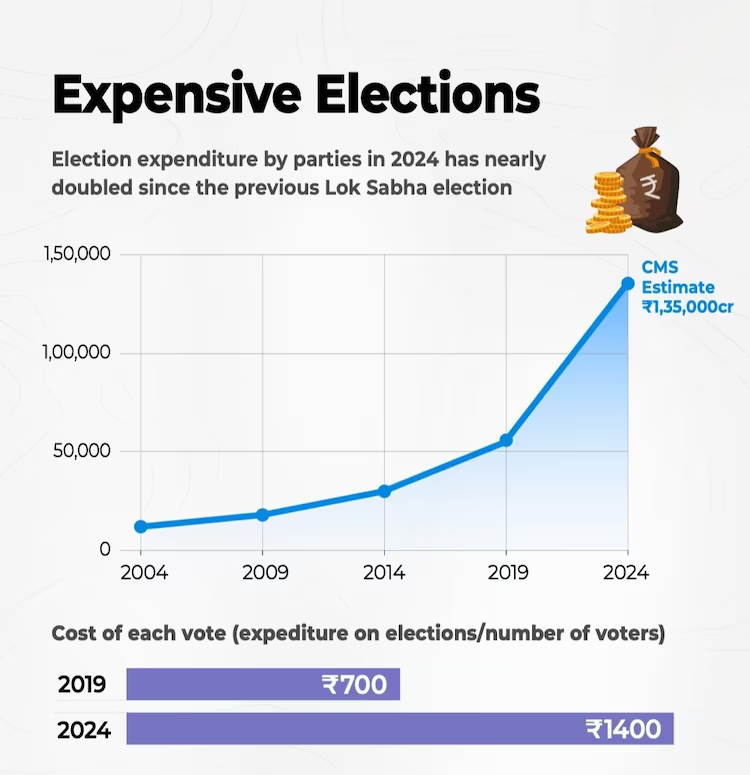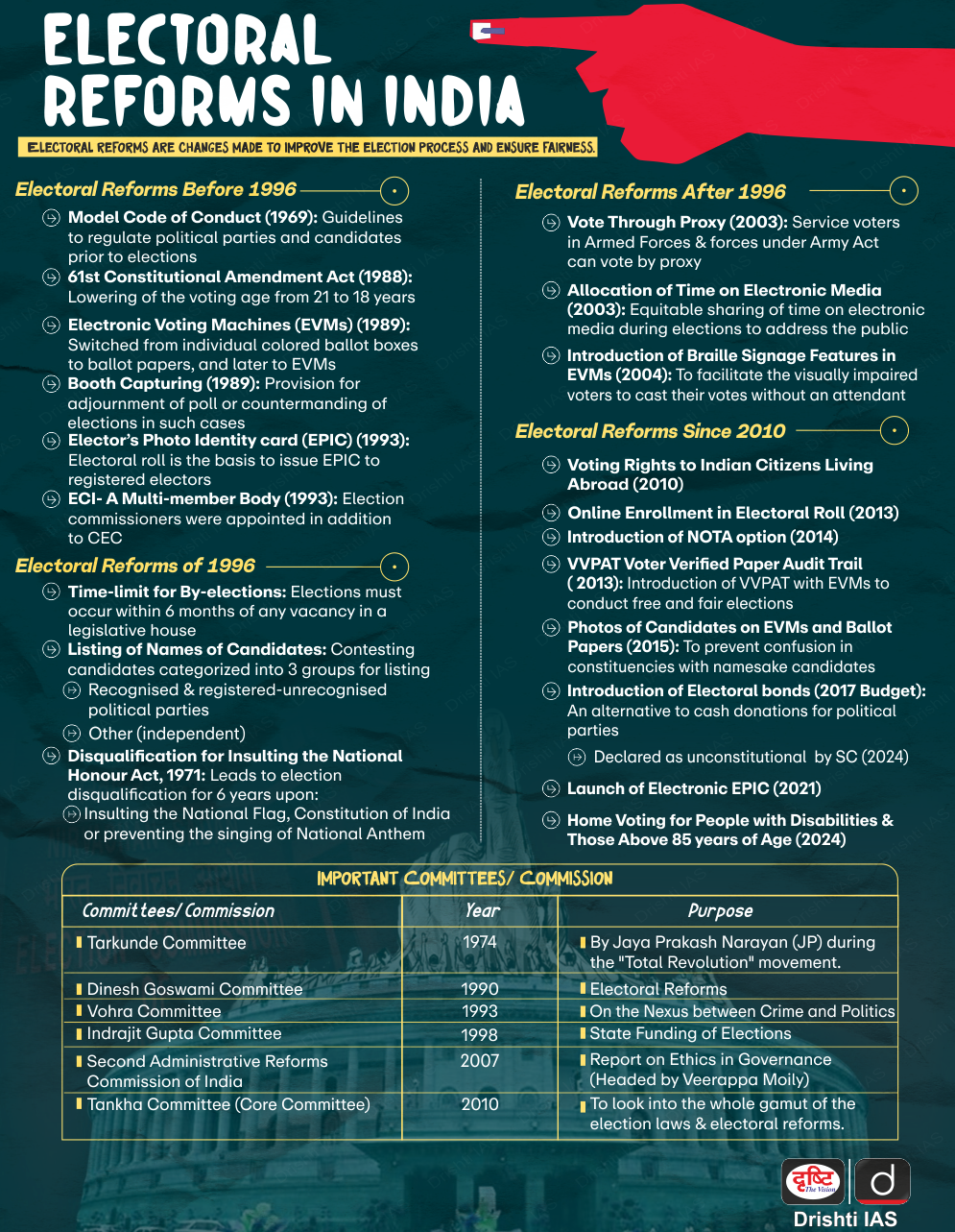Limiting Expenditure on Elections | 30 Oct 2024
For Prelims: Not-For-Profit Organisation, Lok Sabha, General Elections, House of Representatives, National Party, State Parties, Election Commission of India, Indrajit Gupta Committee, Law Commission, State Funding for Elections.
For Mains: Excessive expenditure on elections, their impacts and ways to address them.
Why in News?
According to the Centre for Media Studies (CMS), the total expenditure by various political parties for the general election to Lok Sabha 2024 was around Rs 1,00,000 crores.
- CMS is a not-for-profit organisation that works towards responsive governance and equitable development.
What is the Status of Election Expenditure in India?
- Expenditure Limit on Candidates: The election expenditure limit for candidates is set at Rs 95 lakh for Lok Sabha seats and Rs 40 lakh for Assembly seats in larger states, and Rs 75 lakh and Rs 28 lakh respectively in smaller states.
- Political Party Spending: Currently, there are no expenditure limits imposed on political parties during elections, allowing them unrestricted spending.
- In the 2024 Lok Sabha Election, the cost of a single vote in India has amounted to around Rs 1,400 and total expenditures reached approximately Rs 1 lakh crores.
- Promoting Schemes: Government advertisements, especially before elections, often serve as campaigns for the ruling party.
- The Central government spent Rs 3,020 crore on advertisements between 2018-19 and 2022-23, with higher spending in election years—Rs 1,179 crore in 2018-19 versus Rs 408 crore in 2022-23.
- Comparison with Previous Elections: Candidates initially spent only Rs 25,000 during the first general elections in 1951-52 which now skyrocketed to Rs 75-95 lakh (300-fold increase).
- Additionally, overall election expenditure has risen sixfold from Rs 9,000 crore in 1998 to approximately Rs 1,00,000 crores in 2024.
- Transparency Measures: Political parties are required to submit annual contribution reports to the Election Commission of India (ECI) for donations exceeding Rs 20,000.
- They must also provide Annual Audited Accounts (AAA) and election expenditure reports within 75 days post-election.
- Funding Sources: The vast majority of political funding comes from corporate entities and businesses, creating a strong nexus between donors and politicians.
Status of Election Expenditure in Other Democracies
- United States: In the US, election financing is predominantly derived from limited contributions made by individuals, corporations, and Political Action Committees (PACs).
- US Supreme Court rulings have facilitated the emergence of Super PACs, which can spend unlimited amounts on political campaigning.
- United Kingdom: Political parties face specific expenditure limits when contesting elections.
- Each party is permitted to spend £54,010 for each constituency they contest, leading to an overall cap of £35 million for parties contesting all constituencies.
- During the long campaign phase (five months before the House of Commons term ends), candidates can spend £46,000 to £49,000 per constituency. In the short campaign period (after election announcement), spending is limited to £17,000 to £20,000 per constituency.
How is Election Expenditure Govern in India?
- Representation of the People Act (RPA), 1951:
- Section 77 of the RPA requires candidates to keep a detailed and accurate account of all expenses related to their campaign from the day they file their nomination until the election day.
- Section 78 mandates that every candidate submit their election expense account to the District Election Officer within 30 days of the result declaration.
- Companies Act, 2013: A non-government company with at least three years in operation may contribute up to 7.5% of its average net profits from the last three years to political parties registered under the RPA.
- Foreign Contribution (Regulation) Act (FCRA), 2010: Political parties, candidates, and election-related entities in India are prohibited from receiving foreign contributions.
- This includes funds, gifts, donations, and any financial support from foreign sources.
What are Challenges Associated with Election Expenditure in India?
- Absence of Regulation: Unlike 65 countries, including the US, UK, Canada, and Brazil, India has no limits on political party expenditures during elections.
- It leads to an uneven playing field, favouring well-funded national parties over regional and independent candidates.
- Media Advertising: National and state-level parties allocate a substantial portion of their budgets to media advertisements, surpassing expenditures for grassroots activities like rallies.
- It can marginalise candidates without access to significant financial resources.
- Disproportionate Digital Advertising: The growing influence of digital platforms like Google and Meta (facebook) has widened the spending gap, with national parties investing significantly more in digital advertising than state parties.
- This trend exacerbates existing inequalities and reduces the visibility of smaller parties and candidates.
- Risk of Unaccounted Money: The absence of regulation for third-party campaigners raises concerns about unaccounted money flooding the electoral process.
- There is a heightened risk of quid pro quo arrangements where financial contributions influence political decisions without proper accountability.
What Reforms are Needed in Election Expenditure?
- Expenditure Ceilings: As per the ECI’s ‘Proposed Electoral Reforms’ report in 2016, expenditure ceilings for political parties should be introduced in India.
- It will ensure a more equitable playing field to encourage parties to compete based on ideas rather than financial clout.
- Regulation of Third-Party Campaigners: India should implement formal registration and disclosure requirements for third-party campaigners like Australia.
- State Funding of Elections: The Indrajit Gupta Committee (1998) and the Law Commission report (1999) have recommended state funding for elections, whereby the government would partially finance the election expenditures of candidates nominated by recognised political parties.
- Ban on Government Advertisements: A ban on government advertisements during the six months leading up to elections should be enforced to reduce the advantage held by the ruling party and promote fair competition among candidates.
- Party Financial Assistance: The law must be amended to explicitly provide that ‘financial assistance’ by a political party to its candidate should also be within the candidate’s prescribed election expenditure limits.
- It would close loopholes that allow parties to circumvent spending regulations.
- Comprehensive Electoral Oversight: Establishing an independent electoral oversight body could enhance accountability in campaign financing.
|
Drishti Mains Question: Discuss the challenges associated with election expenditure in India. How can these challenges be addressed? |
UPSC Civil Services Examination Previous Year Questions (PYQ)
Prelims
Q. Consider the following statements: (2017)
- The Election Commission of India is a five-member body.
- Union Ministry of Home Affairs decides the election schedule for the conduct of both general elections and bye-elections.
- Election Commission resolves the disputes relating to splits/mergers of recognised political parties.
Which of the statements given above is/are correct?
(a) 1 and 2 only
(b) 2 only
(c) 2 and 3 only
(d) 3 only
Ans: (d)
Mains
Q. To enhance the quality of democracy in India the Election Commission of India has proposed electoral reforms in 2016. What are the suggested reforms and how far are they significant to make democracy successful? (2017)


